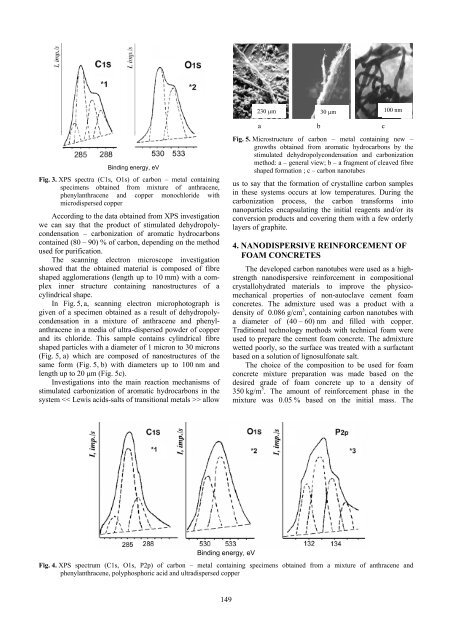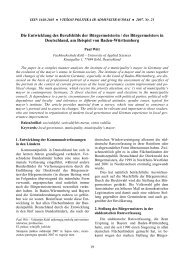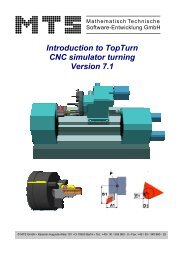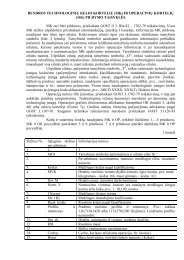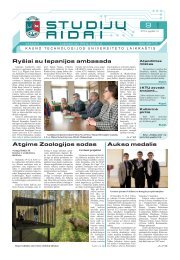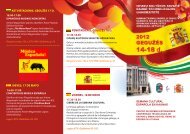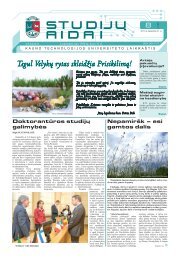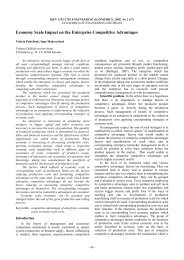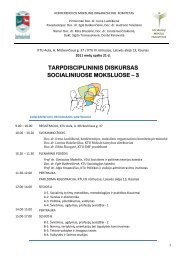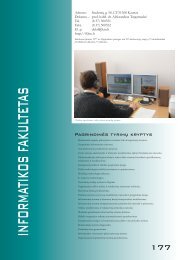cement based foam concrete reinforced by carbon nanotubes
cement based foam concrete reinforced by carbon nanotubes
cement based foam concrete reinforced by carbon nanotubes
You also want an ePaper? Increase the reach of your titles
YUMPU automatically turns print PDFs into web optimized ePapers that Google loves.
Binding energy, eV<br />
Fig. 3. XPS spectra (C1s, O1s) of <strong>carbon</strong> – metal containing<br />
specimens obtained from mixture of anthracene,<br />
phenylanthracene and copper monochloride with<br />
microdispersed copper<br />
According to the data obtained from XPS investigation<br />
we can say that the product of stimulated dehydropolycondensation<br />
– <strong>carbon</strong>ization of aromatic hydro<strong>carbon</strong>s<br />
contained (80 – 90) % of <strong>carbon</strong>, depending on the method<br />
used for purification.<br />
The scanning electron microscope investigation<br />
showed that the obtained material is composed of fibre<br />
shaped agglomerations (length up to 10 mm) with a complex<br />
inner structure containing nanostructures of a<br />
cylindrical shape.<br />
In Fig. 5, a, scanning electron microphotograph is<br />
given of a specimen obtained as a result of dehydropolycondensation<br />
in a mixture of anthracene and phenylanthracene<br />
in a media of ultra-dispersed powder of copper<br />
and its chloride. This sample contains cylindrical fibre<br />
shaped particles with a diameter of 1 micron to 30 microns<br />
(Fig. 5, a) which are composed of nanostructures of the<br />
same form (Fig. 5, b) with diameters up to 100 nm and<br />
length up to 20 μm (Fig. 5c).<br />
Investigations into the main reaction mechanisms of<br />
stimulated <strong>carbon</strong>ization of aromatic hydro<strong>carbon</strong>s in the<br />
system > allow<br />
Binding energy, eV<br />
230 μm<br />
30 μm<br />
a b c<br />
100 nm<br />
Fig. 5. Microstructure of <strong>carbon</strong> – metal containing new –<br />
growths obtained from aromatic hydro<strong>carbon</strong>s <strong>by</strong> the<br />
stimulated dehydropolycondensation and <strong>carbon</strong>ization<br />
method: a – general view; b – a fragment of cleaved fibre<br />
shaped formation ; c – <strong>carbon</strong> <strong>nanotubes</strong><br />
us to say that the formation of crystalline <strong>carbon</strong> samples<br />
in these systems occurs at low temperatures. During the<br />
<strong>carbon</strong>ization process, the <strong>carbon</strong> transforms into<br />
nanoparticles encapsulating the initial reagents and/or its<br />
conversion products and covering them with a few orderly<br />
layers of graphite.<br />
4. NANODISPERSIVE REINFORCEMENT OF<br />
FOAM CONCRETES<br />
The developed <strong>carbon</strong> <strong>nanotubes</strong> were used as a highstrength<br />
nanodispersive reinfor<strong>cement</strong> in compositional<br />
crystallohydrated materials to improve the physicomechanical<br />
properties of non-autoclave <strong>cement</strong> <strong>foam</strong><br />
<strong>concrete</strong>s. The admixture used was a product with a<br />
density of 0.086 g/cm 3 , containing <strong>carbon</strong> <strong>nanotubes</strong> with<br />
a diameter of (40 – 60) nm and filled with copper.<br />
Traditional technology methods with technical <strong>foam</strong> were<br />
used to prepare the <strong>cement</strong> <strong>foam</strong> <strong>concrete</strong>. The admixture<br />
wetted poorly, so the surface was treated with a surfactant<br />
<strong>based</strong> on a solution of lignosulfonate salt.<br />
The choice of the composition to be used for <strong>foam</strong><br />
<strong>concrete</strong> mixture preparation was made <strong>based</strong> on the<br />
desired grade of <strong>foam</strong> <strong>concrete</strong> up to a density of<br />
350 kg/m 3 . The amount of reinfor<strong>cement</strong> phase in the<br />
mixture was 0.05 % <strong>based</strong> on the initial mass. The<br />
Fig. 4. XPS spectrum (C1s, O1s, P2p) of <strong>carbon</strong> – metal containing specimens obtained from a mixture of anthracene and<br />
phenylanthracene, polyphosphoric acid and ultradispersed copper<br />
149


